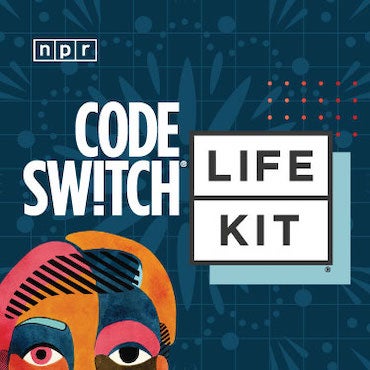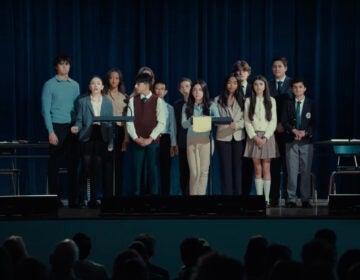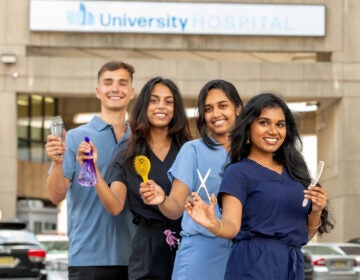Shot and surviving: How the invisible impact of gun violence can shape teens’ lives forever
In the U.S., 6,000 young people are wounded in gun violence each year. The victims are almost never the intended targets, but they're still left with the trauma of the event.
Listen 8:12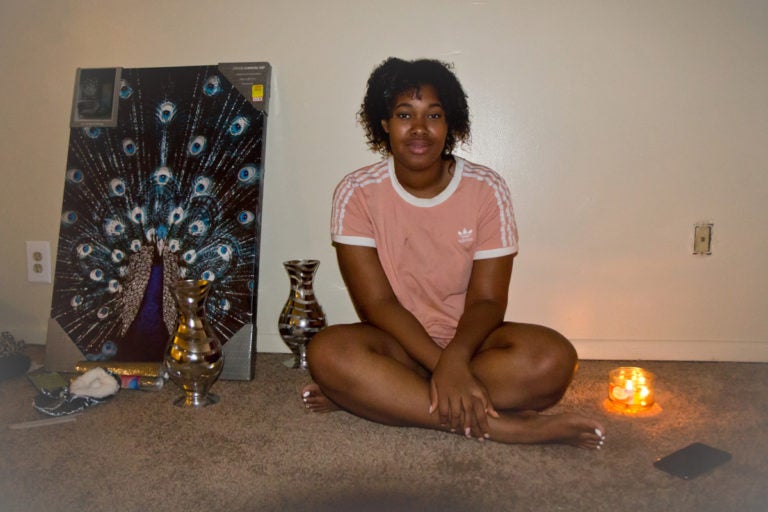
Angel Bowen, 18, at her first apartment in a suburb near Philadelphia. She said she’s most happy when she can spend time alone. (Kimberly Paytner/WHYY)
This story is from The Pulse, a weekly health and science podcast.
Subscribe on Apple Podcasts, Stitcher or wherever you get your podcasts.
Angel Bowen taught herself how to cook. She hovered over a pot of chicken necks in the kitchen of her small apartment, blowing softly on a wooden spoon.
“Yep, I think it’s done,” she said, taking a nibble. “It’s super soft.”
Bowen, 18, just moved into her own place, and the apartment was still mostly empty: an air mattress in the bedroom, a few candles lit in the living room. It was early evening, and she was getting ready for work. She works the graveyard shift in a suburban parking lot, about a 45-minute drive from where she lives. There, under the bright lights of the parking lot, she watches over a Giant supermarket, a Starbucks, a McDonald’s, and a hair salon. Sometimes, she watches Netflix. (She just finished the show “You.”)
“It’s just me in my car, my little car,” she said. “I’m in my own zone, my own bubble. It’s very peaceful, yes. And therapeutic.”
For Bowen, things can go from business as usual to total panic really quickly. To avoid that, she’s set her life up in such a way as to avoid the things that make her anxious: She has trouble sleeping, so she works the night shift. She gets anxious around big crowds, so she lives alone.
All of Bowen’s anxieties — and the adjustments she’s made to avoid them — stem from one night seven years ago, when she was 11 years old.
It was a hot July evening, and she’d spent the day hanging out with her niece and her big sister, Destiny, in her East Lansdowne neighborhood near Philadelphia. That night, the girls were planning to camp out in their mom’s car, the way they often did on warm nights. They’d fold all the seats down, bring in a bunch of pillows and blankets, talk, giggle. They never thought twice about safety.
That night, around 11:30 p.m., they went across the street to the gas station to get some snacks. On the way back, they heard gunshots. Bowen felt a burning sensation in her leg and hopped her way back home, where they realized she’d been hit. They wrapped the wound in a sweater to stop the bleeding.
“[Angel] was just so calm, she called the cops herself,” Destiny Bowen remembered. “She was like, ‘I just got shot, I need an ambulance.’”
Both sisters recalled it took a long time for the ambulance to come. A neighbor down the street had also been hit, and the ambulance went to his house first. When it finally arrived, Angel Bowen said, the paramedics were rude and short with her. It turns out, she’d also been shot in the stomach.
At the hospital, she was joined by her parents and rushed into surgery.
“It was like something out of a movie,” Bowen remembered. “It was all white, so many lights, so many doctors, they was just flippin’ me over back and forth, back and forth … I was like, ’Oh my God, these people are seeing me naked!’”
She underwent several operations, and aside from permanent nerve damage to the top of her foot, she was OK.
At least, physically.
A crisis point
Everything changed for her after she was shot, Bowen said.
“Before that, I was just a happy, carefree child with no cares in the world,” she said. “[It] made me look at people differently.”
While Bowen was still recovering from surgery at Children’s Hospital of Philadelphia, she was approached by a social worker, Laura Vega, a part of CHOP’s Violence Intervention Program. The program works with young people affected by violence over the long term.
For some time after the shooting, Bowen wouldn’t leave the house. Vega connected her to therapy focused on decreasing her trauma symptoms, and gradually returning to a daily routine where she could increase her sense of safety and feel more in control.
But that was difficult since the shooting happened right outside Bowen’s house. “Anything could happen when I go outside,” she said. “Anything. So I never wanted to go out.”
So, after a few months, Vega helped the family find a new place to live.
As time drew near to go back to school, neither Angel nor Destiny Bowen felt ready to be around crowds. So, Vega helped them enroll in Philadelphia Virtual Academy, a cyber school. Angel never went back to a brick-and-mortar school. She graduated last May.
Angel Bowen’s life became smaller and smaller — more and more restricted. Her fear of crowds gave her anxiety attacks that made her feel like her whole body was caving in on itself. She’d avoid it by isolating herself, but, in turn, that made her depressed.
The cycle kept her from doing a lot of the things that other high schoolers enjoy — at least, in the traditional ways they enjoy them.
The cyber school Bowen was enrolled in offered in-person events for all its students in the Philadelphia area, and she did not intend to miss her senior prom. She had a dress custom-made, with silver roses on the bottom, rhinestones on the top, and a long, elegant trail.
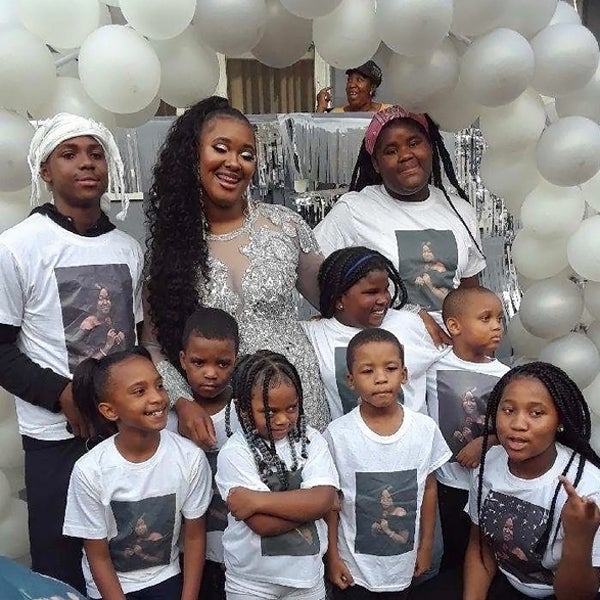
The night of prom, Bowen’s family threw her a send-off party in front of her house, where she posed for photos with everyone. But once she arrived at the prom, from the moment she stepped into the room, she knew she had to leave. There were more people there than she had expected. And it was dark.
“I wasn’t planning on staying anyway,” she said. Bowen and her sisters and her date went to Denny’s for some food, and called it a night.
Unseen, trauma goes untreated
In the United States, 6,000 young people are wounded in gun violence each year. In Philadelphia, where Angel Bowen lives, 491 young people were shot between 2015 and 2019. Sixty-four of them died, but the rest, like Bowen, went on living. The shootings are flashes on the local news, covered more thoroughly and regularly than other incidents of gun violence, in part, because the victims are almost never the intended targets. But after the news cycles move on, those young people are left with the trauma their injuries caused for the rest of their lives.
Laura Vega, at Children’s Hospital of Philadelphia, said she’s seen an increase in the complexity of behavioral health and psychiatric issues among young people, much of which can be attributed to an increase in violence. In part, the issues go ignored and untreated because they’re invisible.
“When you have someone come in on crutches, it’s very easy to say, ‘They have to take an elevator,’” said Joel Fein, an emergency pediatrician and creator of the CHOP Violence Intervention Program. Symptoms of trauma like depression and anxiety can be a lot harder to identify and respond to.
Research shows that young people affected by violence are at a greater risk of experiencing ongoing behavioral health issues. In addition to anxiety and depression, that can mean they are more likely to be suicidal too. And when young people have access to guns, their chances of developing mental health disorders goes up as well.
While they’re in the emergency room, the CHOP program identifies young people affected by violence. It works with them and their families for around six months after the incident, on everything from therapy to navigating the legal or medical system. Therapists offer group sessions, and connect family members to behavioral health resources they may want. The program is grant-funded and free to all patients, but it has very limited capacity.
Fein said it’s hard to get young people to use some of the tools they teach them to manage anxiety, like mindfulness and meditation, in a world where so much is captured on video and lives online.
“It’s just constant reminders of the event,” he said.
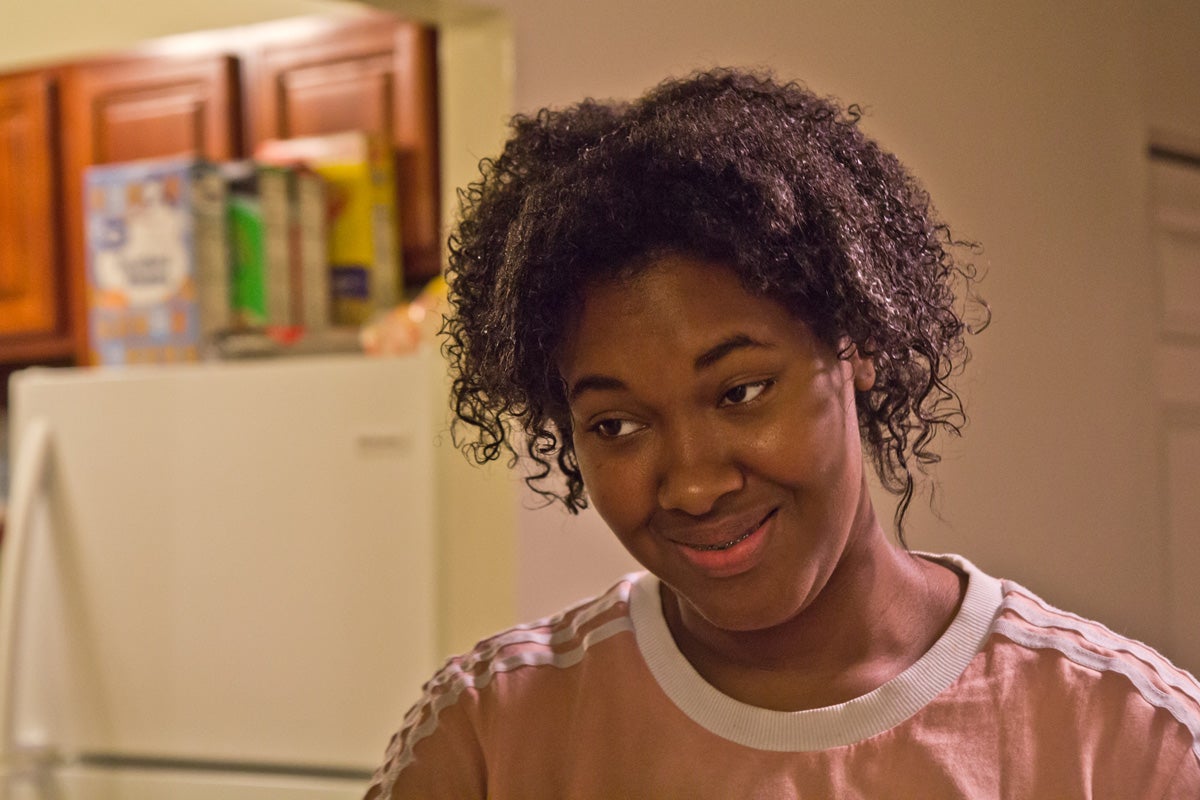
For Angel Bowen, life has become a game of staying ahead of her anxiety — tailoring every aspect of her existence to avoiding that feeling of terror: working at night, living alone. She and her sister Destiny have stayed close, and her sister comes over to her apartment to pop some dinner in the microwave before she, too, heads off to her job working as a security guard on the night shift.
Like Angel, Destiny Bowen loves the work. She likes feeling as if she’s in control, and that it’s her responsibility to keep everyone safe. Soon, she plans to apply for her permit to carry a gun on the job.
“As soon as I turn 21, they’ll get my picture, my money order, and everything else they told me to send in,” said Destiny.
Angel Bowen also plans to apply for a permit to be armed at work, in part because armed guards get paid better.
“Also because in the world that we live in, it’s very dangerous for women,” she said. “All the human trafficking going on, rape, killing, everything. You just need some type of protection over yourself.”
Her experience getting shot plays into her need to protect herself, Angel Bowen said. And, she thinks that’s probably what the people who shot her were trying to do, too: protect themselves.
Still, she’d rather be on the safe side.
WHYY is your source for fact-based, in-depth journalism and information. As a nonprofit organization, we rely on financial support from readers like you. Please give today.
